The World at the Height of the Inca Empire
As a tribal civilization, the Incas had been around since the early 13th century, if not earlier. But as a strong, expansionist empire, the Tawantinsuyu, as it was called, existed for less than 100 years, from approximately 1438 to 1533 (the fall of Cusco).
The Inca Empire was at its height between 1471 and 1525, from the expansionist empire-building reigns of Pachacuti and Huayna Capac, up until Huayna Capac’s death in 1525 and the rapid fall of the empire through civil war, disease and the Spanish Conquest.
But what about the rest of the world during this period? If we freeze the Inca timeline circa 1500 and fly across the globe, what do we see? To find out, let’s take a quick hop across the continents during the height of the Inca Empire…
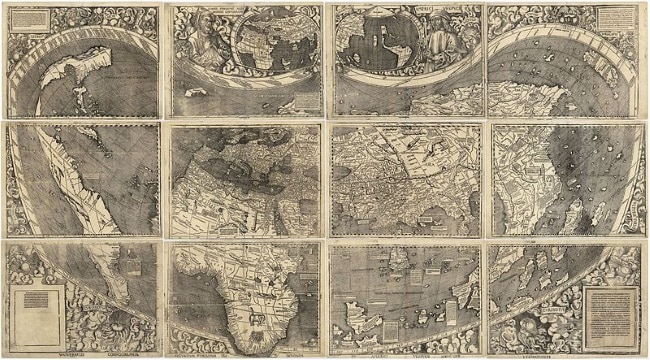
The Waldseemüller map from 1507 is the first map to include the name “America” and the first to depict the Americas as separate from Asia.
The Americas
- While the Inca Empire continued its expansion in South America, the Aztec Empire, or Mexica Triple Alliance, was still trying to expand — or at least consolidate — its borders in the Valley of Mexico. The reign of Ahuitzotl began in 1486, marked by aggressive expansion and the dominance of the Mexica within the Triple Alliance. Ahuitzotl was succeeded by Moctezuma II in 1502. The conquistador Hernán Cortés landed in Yucatán in 1519. Just a year later, Moctezuma — a name now synonymous with the fall of the Aztec Empire — was dead and his empire all but defeated. Tenochtitlan, the capital of the Aztec Empire, fell to the Spanish in 1521.
- In August 1492, Christopher Columbus began his first voyage of discovery. He explored a number of islands, including the Bahamas and Cuba, saying of the local inhabitants: “I could conquer the whole of them with 50 men, and govern them as I pleased.” Along with some gold and some kidnapped slaves, he also presented the Spanish Court with some intriguing new finds such as the tobacco plant, the pineapple, the turkey and the hammock. His return trip and second voyage began in 1493; the third voyage, which touched mainland South America, set sail in 1498.
- In 1497, the explorer John Cabot — under the commission of Henry VII of England — landed on the island of Newfoundland in present-day Canada. His arrival set in motion yet another wave of New World colonialism. As was happening further south, the arrival of the Europeans in North America would also unleash a fatal wave of disease to which the native population (North American Indians) had no natural resistance.
- By 1500, the Maya civilization had reached the very end of its Postclassic Period. In the Yucatán and southern Mexico, the fractured city-states of what was once a more unified civilization were squabbling among themselves. Ironically, their very lack of unity, specifically the absence of an all-important political center, made them far more resistant to the imminent arrival of the conquistadors. Nojpetén, the capital of the last Maya kingdom, fell to the Spanish in 1697.
- The name “America” was first used in 1507, in the book Cosmographiae Introductio.
- In April 1513, the Spanish explorer and conquistador Juan Ponce de León discovered Florida.
__________________________________________
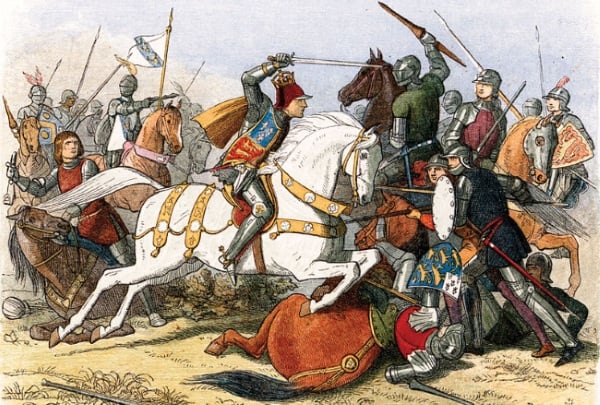
In August 1485, the Houses of Lancaster and York clashed at the Battle of Bosworth, the last significant battle of the Wars of the Roses.
Europe
Life was very different In the Old World in the late 1400s. Technological advancements, artistic developments, religious disputes and war continued apace. And while the shadow of the Spanish conquistadors crept ever closer to the Inca realm, Europe went about its business.
- Martin Luther was born in Saxony, then part of the Holy Roman Empire, in 1483. In 1517, he wrote The Ninety-Five Theses on the Power and Efficacy of Indulgences, a work widely regarded as the initial catalyst for the Protestant Reformation.
- In 1485, the Battle of Bosworth saw the Tudor family take power in England. Henry VII would rise to power, followed by Henry VIII in 1509.
- In 1492, the same year as Columbus’ first voyage, a recently united Christian Spain forced the surrender of the last Muslim stronghold in Granada. The same year, the Alhambra Decree was issued by the joint Catholic Monarchs of Spain, ordering the expulsion of Jews from the Kingdoms of Castile and Aragon.
- Sometime around 1500, Europeans developed the wheellock firearm, the first self-igniting firearm and a significant improvement over the matchlock (invented c. 1475). The Incas, of course, had yet to experience the frightful sounds and effects of gunpowder weapons.
- Between 1503 and 1506, Leonardo da Vinci painted his Mona Lisa, a cheeky little number that would become rather popular. Leonardo died in 1519, the same year in which Hernán Cortés began his conquest of the Aztecs. In 1504, Michelangelo completed his masterpiece of Renaissance sculpture, David. Machiavelli, meanwhile, was working on The Prince, probably completed in 1513 but not published until 1532 — five years after Machiavelli’s death.
ENTERTAINMENT TIP: If looking for fun at night, or to watch sports during the day, or even a taste of home, visit the Wild Rover Hostels Chain for great food, sports and beer! Entrance to their bars is free even for non-guests
- In Russia, Ivan the Great was nearing the end of his rule, having already cemented the foundations of the Russian state. He died in Moscow in 1505.
- From 1508 to 1516, various European nations — primarily France, the Papal States and the Republic of Venice — engaged in the War of the League of Cambrai. The conflict was waged by an anti-Venetian alliance that sought to partition Venetian territory.
- In 1513, James IV of Scotland was killed during the Battle of Flodden. The invading Scots army suffered a crushing defeat against English forces under the command of Thomas Howard, Earl of Surrey.
- Sometime around 1514, Nicolaus Copernicus — born in the Kingdom of Poland — was dabbling with some completely crazy ideas regarding the heliocentric hypothesis. His outlandish model placed the Sun rather than the Earth at the center of the universe.
- The Royal College of Physicians of London was established in 1518.
- While Francisco Pizarro was busy running the newly founded city of Lima, Sir Thomas More was busy getting his head chopped off. The author of Utopia and former Lord Chancellor of England had seriously riled King Henry VIII, a situation that rarely turned out well unless you happened to be the king.
______________________________________
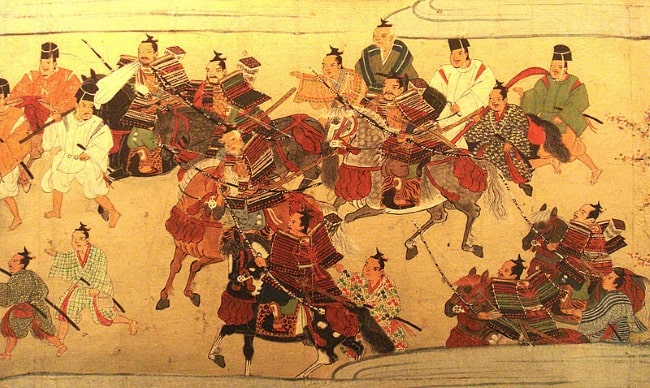
Mounted Japanese samurai of the Muromachi period, 1538.

Asia
- In 1453, the Ottomans conquered Constantinople (with the help of cannons) and overthrew the Byzantine Empire. A period of expansion followed, with the Ottoman Empire (Turkish Empire) becoming a powerful force across multiple continents. By the end of the reign of Suleiman the Magnificent in 1566, the Ottoman Empire held territory in Southeast Europe, the Middle East, the Caucasus, North Africa, and the Horn of Africa.
- In 1498, Vasco de Gama became the first European to reach India by sea. This was the first ocean route to link Europe and Asia, connecting the West and the Orient.
- In 1502, the Portuguese Empire established the first European trading center at Kollam, Kerala. This marked the start of the colonial era in India. By 1526, the powerful Mughal Empire had emerged; within 30 years, it would rule large parts of the Indian subcontinent. Gunpowder warfare was already prevalent in India during this period.
- In 1513, Jorge Álvares became the first European explorer to reach China and Hong Kong by sea. Three years later, Rafael Perestrello (a cousin of Christopher Columbus) became the first European to land on southern mainland China. Unlike events set to unfold in South America, trade between Europe and China would be more dominant than conquest and warfare (there were, of course, a number of less-than-diplomatic incidents).
- China itself was firmly under the rule of the Ming Dynasty, which had been in power since 1368. The Empire of the Great Ming was an advanced military might, but Mongol incursions during the 15th and 16th centuries still prompted the Ming authorities to reinforce the Great Wall (the construction of which originally began in 220 B.C).
- In 1500, Japan was in the midst of the Sengoku (“Warring States”) period, a period of military conflict, violent power struggles and social upheaval that began in 1467 and would last until about 1603. The first European contacts began in 1543, when several Portuguese were shipwrecked on the island of Tanega. In the following years, the Japanese were introduced to weapons such as the arquebus and the European-style cuirass. A period of European-Japanese trade — known as the Nanban trade period — followed the arrival of the Portuguese.
___________________________________
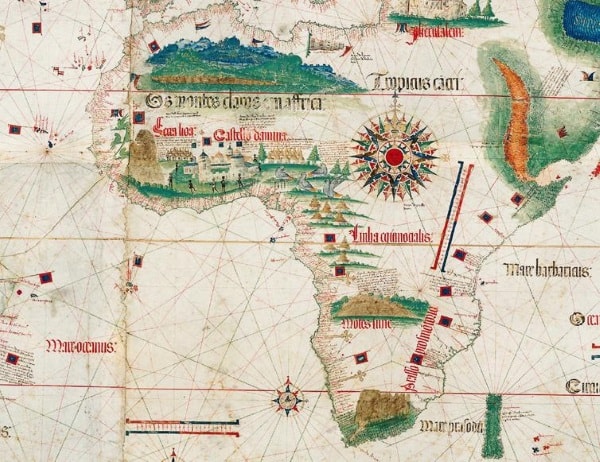
Cantino map of Africa, 1502.
Africa
At the time of the Inca Empire, the geography and culture of Northern Africa was comparatively well known to European and Arabian powers. Southern Africa, however, remained largely unexplored.
- A number of major African powers flourished or faded during the 15th and 16th centuries. The Songhai Empire was firmly established in the Sahel region of Northern Africa, with cities such as Gao and Timbuktu. In 1483, the Portuguese explorer Diogo Cão sailed up the uncharted Congo River and became the first European to encounter the Kongo Kingdom of west central Africa. In 1485, the first European explorers made contact with the Benin Empire, located in what is now Nigeria. The Portuguese began trading guns and manila with Benin, in exchange for ivory, pepper and palm oil. The first English expedition to Benin was in 1553.
- In 1488, Portuguese seafarer Bartolomeu Dias became the first European to venture round the southern tip of Africa. This was a major event, proving that the Indian Ocean was accessible from the Atlantic.
- The trade in African slaves was well established by 1500. Portuguese settlements had been established on the islands of Sao Tome and Principe just off the African Atlantic coast, and Portuguese traders would soon begin taking African slaves to South America. It wasn’t long before the first African slaves could be found working in the former territories of the Inca Empire.
__________________________________________
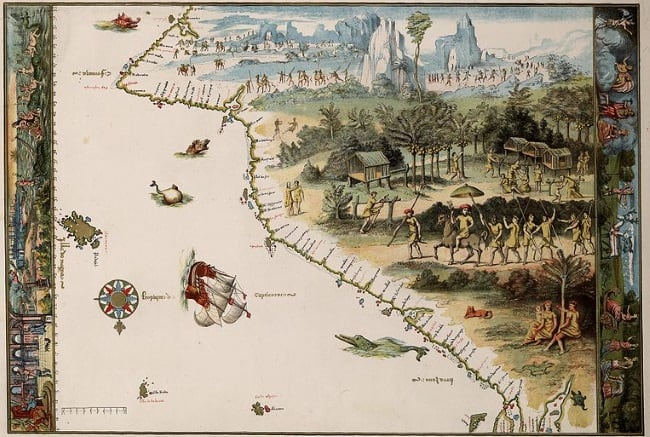
“The first Map of Australia from Nicholas Vallard’s Atlas, 1547”
Australasia and Oceania
- The Dutch navigator Willem Janszoon is generally regarded as the first European to have seen the coast of Australia, during a voyage in 1606. The theory of the Portuguese discovery of Australia, however, claims that early Portuguese navigators were the first Europeans to sight Australia sometime between 1521 and 1524. Throw in claims by China, France, Spain, India and even Phoenicia and you have a real discovery spat.
- Prior to the arrival of European explorers, Aboriginal Australian communities lived across much of Australia, both in the arid interior regions and colder, wetter regions such as Tasmania. Most Aboriginal Australians were hunter-gatherers, including highly skilled fisherman working along the coasts and rivers.
- In 1500, the Māori of New Zealand were entering what is considered their Classic period (1500-1642). During this period, the Māori reached the peak of their crafting abilities, including fine weapons, ornaments and elaborately carved canoes. The first Europeans known to have reached New Zealand were Dutch explorer Abel Tasman and his crew, who arrived in 1642. The first instances of contact rarely ended well; rather than being invited to lunch, the Europeans sometimes ended up as lunch (according to some accounts…).
________________________________
The events above offer a brief snapshot of our restless world during the height of the Inca Empire and the Age of Discovery. If you would like to add any global events that took place during this period, feel free to include them in the comments section below. Thanks!
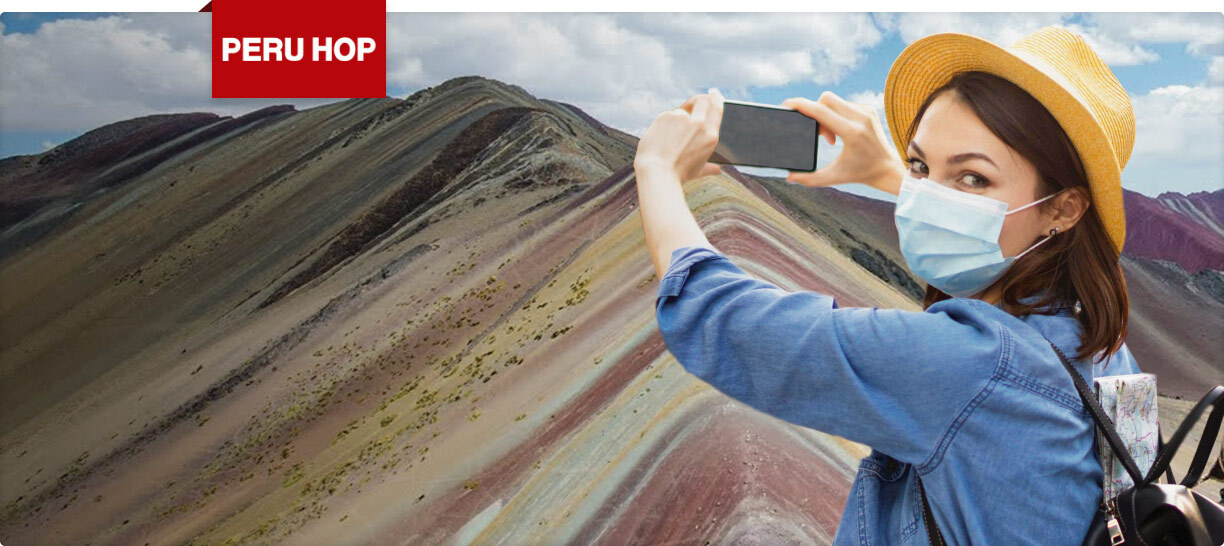


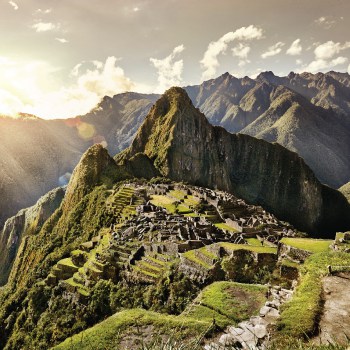







3 comments for “The World at the Height of the Inca Empire”